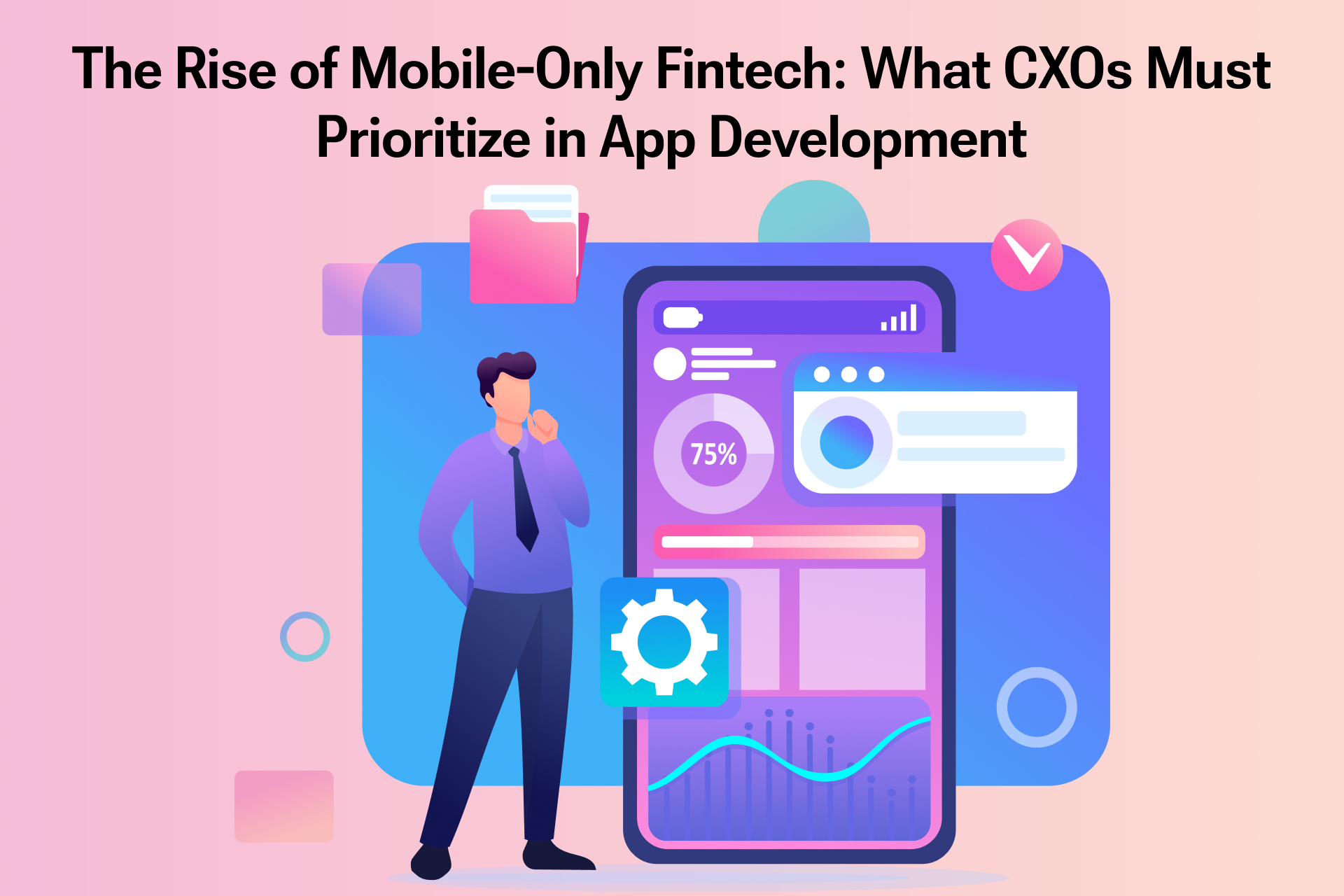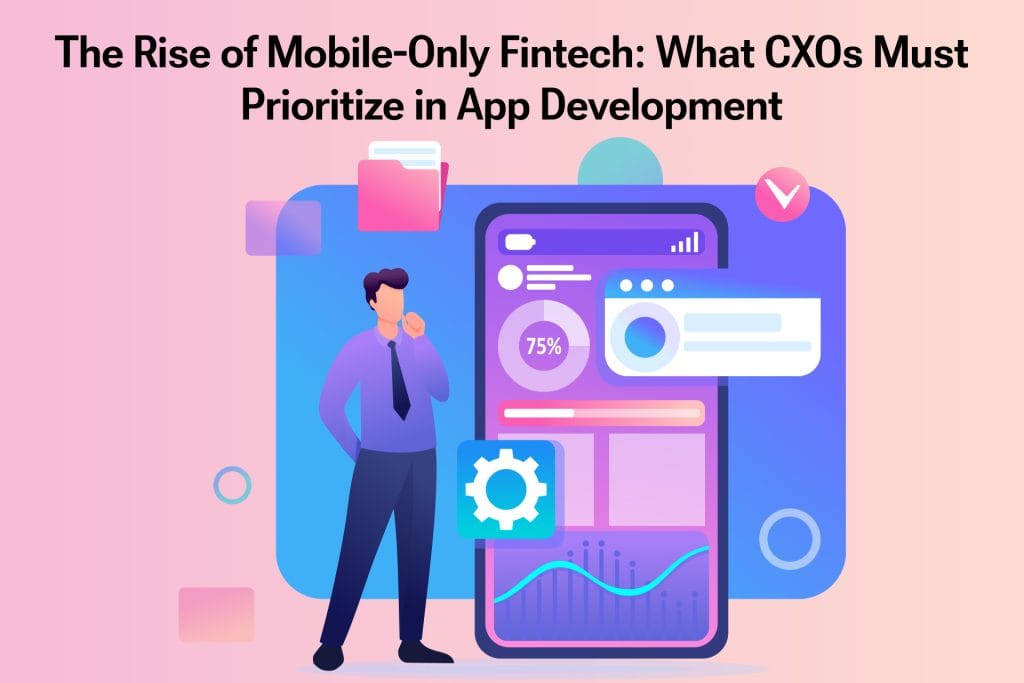The fintech landscape is undergoing significant transformation. No longer confined to traditional banking or even web-based platforms, financial services are rapidly becoming mobile-only. For a growing segment of the global population—especially in emerging markets and among digital-native consumers—mobile devices are the only way they interact with financial services.
From digital wallet integration and neobanks to investment platforms and insurtech apps, mobile-only fintech solutions are not just a trend; they are fast becoming the norm. For CXOs—particularly CTOs, CIOs, and Chief Digital Officers—this shift represents a strategic inflection point. The success of a fintech app depends not just on innovative features, but on how well it adapts to the mobile-first reality.
Partnering with a mobile app development company in USA can help fintech businesses build secure, scalable, and user-centric mobile solutions tailored to this evolving market.
In this blog, we’ll explore why mobile-only fintech app development is on the rise, the critical factors driving this trend, and most importantly what CXOs guide to fintech apps must prioritize when developing mobile fintech applications.

Why Mobile-Only Fintech Is Booming
Here are several reasons why you should invest in fintech mobile app development:
1. Changing User Behavior
Today’s consumers live on their smartphones. Mobile banking, payments, stock trading, and even cryptocurrency transactions are now expected to be available at their fingertips. Mobile banking app development offers the convenience, speed, and personalization users demand—especially millennials and Gen Z who often bypass traditional banks altogether.
2. Global Smartphone Penetration
Smartphone adoption has exploded globally, particularly in emerging economies where traditional banking infrastructure is lacking. For many people in Africa, Southeast Asia, and Latin America, a mobile phone is their first and only gateway to the financial system. Mobile-only fintech app development is filling the void left by legacy banks.
3. Cost-Effectiveness for Fintech Startups
Developing a mobile-only solution is more cost-effective than building for both web and desktop interfaces. Many fintech startups, especially in their MVP (Minimum Viable Product) phase, prefer to go mobile-first to reduce costs while maximizing reach.
4. Advanced Mobile Technologies
With innovations like biometric authentication, push notifications, QR payments, NFC, and real-time predictive analytics in finance, mobile banking app development can now offer a more secure and engaging experience than ever before.
CXO Priorities in Mobile-Only Fintech App Development
With this growing reliance on mobile fintech, CXOs must rethink their mobile-first fintech strategies. Below are key priorities to focus on:
1. User-Centric Mobile UX Design
Your app’s success starts with the user experience. Fintech is complicated by nature, but your app must make it feel simple.
What to prioritize:
Minimalist interface: Clean, intuitive screens that reduce cognitive load.
Onboarding simplicity: One-tap login, KYC processes with OCR and biometrics.
Speed and responsiveness: Optimize for low latency and fast navigation.
Accessibility: Support for visually impaired users, multiple languages, and offline modes for rural connectivity.
CXO Tip: Partner with UI/UX designers who specialize in fintech usability and follow human-centered design principles.
2. Security by Design
Trust is everything in fintech. From day one, mobile banking app security must be embedded into every layer of your mobile app architecture—not tacked on later.
What to prioritize:
Biometric authentication (face ID, fingerprint)
End-to-end encryption
Multi-factor authentication (MFA)
Fraud detection using AI/ML models
Regular penetration testing and vulnerability scans
CXO Tip: Appoint a Chief Information Security Officer (CISO) or work with a vCISO to conduct routine risk assessments.
3. Regulatory Compliance & Data Privacy
Financial apps are tightly regulated. Ignoring compliance can result in legal penalties, reputational damage, and even shutdowns.
What to prioritize:
Local compliance (e.g., GDPR in Europe, RBI in India, CCPA in California)
Transaction audit logs: Maintain records for regulators and customers.
Consent-based data sharing (in line with Open Banking principles)
CXO Tip: Embed compliance officers early in your development cycle and keep legal teams closely involved.
4. Cloud-Native Infrastructure
The scalability, flexibility, and cost-efficiency of cloud-based infrastructure make it ideal for mobile fintech apps.
What to prioritize:
Microservices architecture: Enables modular, independent deployments.
Auto-scaling: Handle sudden user spikes with zero downtime.
Disaster recovery plans: Cloud redundancy and backup mechanisms.
DevOps automation: CI/CD pipelines to accelerate release cycles.
5. Real-Time Analytics & Personalization
Modern users expect apps to “know” them. Real-time analytics empower personalization, fraud detection, and better customer service.
What to prioritize:
Monitor in-app actions for UI/UX and security improvements.
Budgeting tips, savings suggestions, investment options.
AI-powered assistants for customer queries and transactions.
Real-time transaction alerts, reminders, and offers.
6. Offline Functionality & Low Bandwidth Optimization
Not all users have access to high-speed internet. For mobile-only fintech apps, offline capabilities are not just a feature—they’re a necessity.
What to prioritize:
Lightweight app design: Optimize for <30MB size.
Caching capabilities: Save data locally for basic functionality offline.
Progressive loading: Fetch essential data first and load others in the background.
Graceful error handling: Let users retry transactions without app crashing.
CXO Tip: Test your app in tier-2 and tier-3 cities, not just metros, to validate real-world performance.
7. Agile & Iterative Development
A fintech app is never “finished.” New regulations, user feedback, and market demands require constant iteration.
What to prioritize:
Launch fast with core features, then iterate.
In-app surveys, app store monitoring, and A/B testing.
Monthly or bi-weekly sprints with features and bug-fix rollouts.
Crowdsource security testing to find hidden flaws.
CXO Tip: Build a cross-functional product team that includes developers, QA testers, designers, and compliance specialists.
8. Cross-Platform Compatibility
While you may focus on mobile-only now, it’s smart to future-proof your app for eventual expansion to web or wearables.
What to prioritize:
Flutter or React Native frameworks for cross-platform development
Separates business logic from platform UI
Makes future channel expansion smoother
CXO Tip: Choose development tools and architecture that allow you to scale across platforms without starting from scratch.
Final Thoughts: Mobile-Only Fintech Is the Future
The shift to mobile-only fintech app development is more than a convenience—it’s an evolution of how financial services are delivered and consumed. For CXOs, this shift is both an opportunity and a challenge.
A successful mobile fintech app isn’t just about packing in features—it’s about understanding your users, building trust, ensuring compliance, and leveraging the right technologies to deliver personalized, secure, and seamless experiences.
If you’re a fintech leader, now is the time to double down on mobile innovation. The companies that build intelligently, iterate rapidly, and prioritize user experience will emerge as tomorrow’s financial giants.
Tradersdna is a leading digital and social media platform for traders and investors. Tradersdna offers premiere resources for trading and investing education, digital resources for personal finance, market analysis and free trading guides. More about TradersDNA Features: What Does It Take to Become an Aggressive Trader? | Everything You Need to Know About White Label Trading Software | Advantages of Automated Forex Trading









